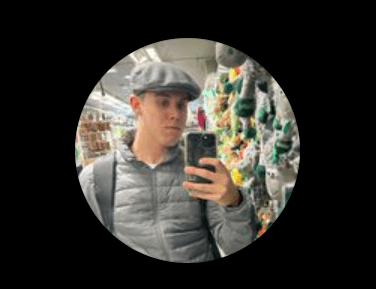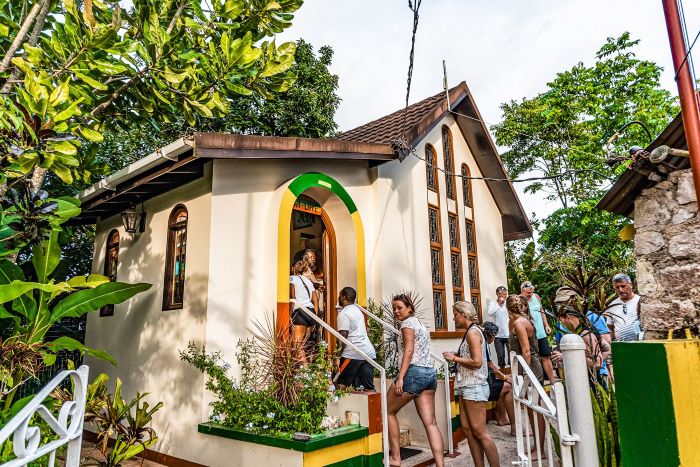The Bob Marley Museum is the former home of Reggae legend the Hon. Rebert Nesta Marley. Six years after his death in 1981, his wife Rita Marley turned it into a museum to celebrate his life.
This museum displays Marley’s treasures and features a well-equipped 80-seat theatre, a photographic gallery, a record shop, and a gift shop that sells Bob Marley memorabilia.
Purchase in 1975, this property at 56 Hope Road reflects the architecture of its era. The two-story structure lower is masonry, while the upper is timber. Above the main portion of the building is a tipped roof with an engaged gable segment covering the entrance.
The building is still original and reflects many of the period’s characteristics. These include the wide moldings, the handmade wooden stair handrails, and the latticework throughout with unique arched-shaped doorway and sash windows.
Visiting the Bob Marley Museum never crossed my mind despite living in Kingston for many years. I drove past many times, but I took the local culture and its ambassadors for granted, like most Jamaicans. I thought I knew everything because I was a part of the culture.
Since I started exploring the island and blogging, I realized I was ignorant of my country’s culture and history. I was compelled to tour Bob Marley because I wrote a post on Kingston attractions. It is a major attraction in the city and one of the few I have never seen.
My visit was during the pandemic; luckily, it was on a Friday because that’s the only day they opened. I learned that you had to make an appointment before going.
I was among the last tour group in the late afternoon. We waited for almost an hour to start our tour at the One Love Cafe, which only served natural punch, water, and juice. Entry cost me J.M. $2000 (local rate).
Bob Marley’s melodies in the background set the tone for the anticipated tour. While a few tourists did their ritual_ posing for photos with the life-sized Bob Marley statue at the museum entrance.
I observed numerous murals on the walls reflex the Rastafarian movement and lifestyle. However, the most impactful pictures on the front lawn were Bob Marley, Former Prime Minister Michal Manley, and the opposition leader Edward Seaga on stage together, holding hands. Knowing that backstory made it even more touching.
The tour started with a watch session at the 80-seat capacity theatre, where they showed a documentary of his life, including recordings of him speaking and playing football (soccer).
He surrounded himself with great people on the same mission of bringing Raggae music to the world. His producers, band manager, backup signers, artistic director, and managers were all talented. All core members of his band had successful solo careers and are legends. It is hard to think of Bob Marley without Peter Tosh, Bunny Wailer, The Ithrees Carline Davis, Judi Mowatt, and Rita Marley.
His humble beginning is an inspiration for me. It shows you can impact the world with talent, drive, and desire.
What I found intriguing was that despite his humility, he was a perfectionist and a decisive leader who demanded the best from those around him.
After getting a synopsis of his life, we passed through the gift shop, where authentic souvenirs were on sale.
We were all eager to tour the museum in the main building, so nobody stopped to buy anything.
Table of Contents
Touring the main museum

His former dwelling, which is immaculate, showed his life work and achievement. His posthumous Grammy award is a standout for me. It showed that when you do great things, it lives on forever.
The tour’s highlight was standing in the studio where Bob Marly created some of his greatest songs. I could only picture some of the most extraordinary musicians I have ever seen singing “Stir It Up.”
Although retired since music production moved to Tuff Gong Studio, the original mixing board was still operational.
I could only imagine the creative energy in that space with some of the most excellent musicians the world has ever heard, all crammed in that little studio on 56 Old Hope Road with one objective: creating great music.
The main bedroom was an exciting place; there was a collection of memorabilia from all over the planet received from some important people. However, most people seemed to be intrigued by his king-size bed. Some excitingly asked if that’s where he created all his children.
Outside his bedroom on the porch is a giant hammock; we were told it was one of his favorite spots to hang out with his children.
The constant battle between good and evil is a never-ending saga that features heavily close to the end of the tour. A giant bullet hole in the wall close to the exit of the Bob Marley museum was a stark reminder.
The wisdom of Bob and the people in charge of his estate preserve it as a warning. Good people must be vigilant because evil is always lurking, waiting for an opportunity to destroy. Luckily for Bob Marley, it wasn’t his time to transition. One bullet struck his arm, and another grazed his chest despite being shot at close range.
The attempt on his life did not stop him from performing at the National Heroes Park free concert. But, on the contrary, it gave him the courage and inspiration to try to end Jamaica’s senseless violence. Moreover, the invitation of Jamaica’s two political rivals responsible for the violence on stage and having them hold hands in a show of peace and unity highlighted his legendary performance.
But unfortunately, it was not enough to get the country back to what it was before the divide. Instead, it mushroomed—the legacy of that violent period in the island’s history continues and has even worsened.
It must have taken great courage to perform with a bullet lodged in his arm from a near-death experience. However, standing beside and holding the hands of the men who might have been responsible showed he was brave and a man of peace.
At the end of our tour, we got a lesson in percussion playing from the legendary Bongo Herman. A permanent fixture at the Bob Marley Museum, his warm personality, and ingenuity capture his audience’s attention. He skillfully played his drum and demonstrated how they created the unique sounds accompanying numerous infectious reggae beats. Favorite among his ensemble is the Wah Wah, so named because of its sound. A hole in the nine-inch pipe is manipulated with the thumb when hit.
In my mind, his genius and eccentricity are only comparable to the late great Lee Scratch Perry, who inspired him.
Pictures of his interactions with famous people, including Jamaican musicians, are displayed along with samples of his music.
Tuff Gong record studio is another section of the Bob Marley Museum brand. You have the option of booking a combined tour that covers the Museum and Record studio. You get to see how they make music, from the recording to production, and how they did it back in the day.
Located at 220 Marcus Garvey road, acquiring this property was sweet revenge for Bob Marley. During a different era in Jamaica’s culture, they discriminated against Rastafarians; Bob Marley was denied access to the recording studio that occupied this premises because of his religion.
He made a vow that he would buy that property when he got rich enough to afford it. He kept his promise, but unfortunately, he died a few months after its purchase.
However, his son Ziggy Marley ensured he fulfilled his father’s wishes. Tuff Gong is a World-renowned recording studio that sells millions of records.
Opening hours and entry cost
The Bob Marley museum is open from Monday to Saturday from 9:30 am to 4 pm. They are closed on Sundays, Bob Marly’s birthday, and public holidays. There is a tour every half an hour.
However, they operated only on Fridays because of the pandemic on my last visit. So things might change depending on the infection rate on the island. Book your tour through their website or call before going.
The entry cost is US$25 for adults and children over 13 years old, US$12 for children 4-12 years old, and is free for persons under four years old.
Bob Marley Museum on Hope Road is about 90 kilometers or 56 miles from Ochi Rios, traveling by the toll, which will take an hour to get there, depending on Kingston’s traffic. So I will take a bit longer traveling by the other route.
You will travel about 175 Kilometers or 109 miles from Montego Bay which will take two hours and forty-six minutes.
From Negril, Bob Marley Museum is 222 Kilometers or 138 miles, just about four hours and fourteen minutes. Traveling by Highway 2000 is 254 kilometers or 158 miles, just two hours and fifteen minutes away.
If you are staying on the North Coast, you can get to the Bob Marley Museum in Kingston. If you want to experience the island like a local, taking public transport is one. It is safe but not the most convenient way to travel. Perfect for adventurous individuals who want to fully indulge in the culture or persons traveling on a shoestring budget. Here is a guide on how to use Jamaica’s public transport.
Renting a vehicle and driving to the location is another way. You have good roads and the flexibility to stop and enjoy other attractions at your leisure. However, it can be dangerous if you are not a confident driver. Some roads are narrow, and Jamaican drivers speed. Some are aggressive, especially taxi and minibus drivers. This guide on driving in Jamaica will help you to navigate safely.
Hiring a driver is a good option; you can enjoy the lovely scenery without worrying about navigating Jamaica roads. There will be someone Knowledgeable who can guide you on the best routes and other attractions that you might enjoy. Understanding the culture will help you better navigate; check this post on must-know tips for travel to Jamaica; it is helpful.
Traveling with a tour group is another option; there many tour companies on the North Coast. You pay one price, and everything is taken care of. These tours sometimes include other locations in Kingston, such as Devon house. While it is convenient, it might not be the best option. They usually stick to a schedule and are not flexible because they cater to many people. Sometimes, the cost is high and may not be the best option if you work with a small budget.
If traveling with a group is best for you, check with your hotel, they normally have companies they recommend. Some people are budget conscious and want the best deals.
Places connected to Bob Marley’s story
From birth to the final resting place, several places and people on the island feature significantly in Bob Marley’s story. They are worth visiting if you want to learn the legend’s history and better understand his life.
Nine Mile, between Claremont and Alexandria, is the birthplace and final resting place of Robert Nesta Marley. He was born in a small cottage in the rural village of Nine Mile and lived there until he was 13. His house and community inspired many of his well-known songs.
A visit to Bob Marley’s home at Nine Mile includes a property tour from Rastafarian guides, which usually consists of a rendition of one of Bob’s songs, memorabilia, his famous “rock pillow” where he rested his head for inspiration, and the Marley mausoleum.
There are two tombs in the mausoleum, one where Bob Marley is buried along with his half-brother, Anthony Booker. The second tomb is Cedella Booker, Bob Marley’s mother, sometimes called “Mamma Marley.”
Trench Town, Known as the Hollywood of Jamaica in the 1960s, was the birthplace of Rock Steady and Reggae. The home of Bob Marley in his youthful days and the community that molded him.
For Aspiring musicians in that era, Trench Town was the place to learn from the greats and get inspiration. It is no secret that Bob Marley revered this place. He always celebrated Trench Town, especially in popular songs like “Trench Town Rock” and “No Woman No Cry.”
Liberty Hall was the meeting place and cultural center Of Marcus Garvey, lead U.N.I.A. If you are familiar with Bob Marley and the Rastafarian movement, you would know Marcus Garvey’s influence on them. They draw a lot of inspiration from his principles and philosophy, reflected in their music and lifestyle.
Liberty Hall is now a museum showcasing Marcus Gravey’s work.
Peter Tosh was a Wailers’ reggae group member, later becoming Bob Marley And The Wailers. He was a core member who taught Bob how to play the guitar. However, his strong personality and displeasure of being cast in a supporting role saw him depart from the group to pursue a solo career.
He had a successful career, and his impact on reggae music compared to Bob Marley. However, his revolutionary stand and uncompromising brand of reggae did not get the same acclaim as his former bandmate.
The Peter Tosh museum, located at the Pulse Complex in New Kingston, opened in November 2016 to celebrate the life of a great Jamaican Musician. Among the many memorabilia on display is the infamous M16 guitar.
Cane River, located in Bull Bay Saint Andrew, is a waterfall Bob Marley visits often to swim and wash his locks. In one of Bob Marley’s famous songs, Trench Town Rock, he sings about Cane River, ” uppa Cane River to wash my dread, upon a rock I rest my head.”
It is easy to find; the left turn after passing the Bull Bay police station will take you there.
Here are some options if you are in Kingston and want to explore other places after visiting the Bob Marley Museum. Some are my favorite chill spots in Kingston. All are free except for the Hope Zoo; entry costs Jm$1500.
Visit Devon’s House for the best-tasting ice in the world, try their famous goat patty or take a tour of the mansion.
Victoria Pier gives a great view of Kingston Harbour. Watch ships entering and leaving the harbor and sunset while eating fish at Gloria Sea Food, drink, and watch planes arrive and depart from the Norman Manely Airport.
The National Gallary Of Jamaica is the most extensive public art gallery in the English-speaking Caribbean, located in downtown Kingston. They showcase the work of some of Jamaica’s most famous artists.
Palisadoes is the small strip of land that connects Port Royal to Kingston; it runs Parallel to Kingston Harbor; it’s an excellent place to go for a jog, watch the sunset, fish, or watch ships in the harbor.
Port Royal is Jamaica’s first city and once was the wealthiest port in the Americas; tour the ruins, drink at a local bar, or eat fish at one of two Gloria’s Sea Food restaurants.
Kingston Craft Market is a must-stop if visiting Down Town Kingston. It is on the waterfront, and they sell authentic Jamaica craft items at affordable prices.
Emancipation Park is one of the best-kept parks in Kingston, located in the heart of New Kingston. It is an excellent place to relax or jog.
Hope Garden and Zoo is the largest recreational park in Kingston and one of the largest zoos in the Caribbean. Visit the zoo, which costs $1500, or chill at one of the many beautiful gardens that are free.
National Heros Park is at Hero’s circle. It is a massive property where lost recreational activities take place. All the national heroes of Jamaica have a shrine built in their honor. Also, it is the burial ground for Jamaica’s past Prime ministers and Nationals who have contributed significantly to the island’s development. Marcus Garvey is the only National Hero buried at Heroes Park.
Independence Park is Jamaica’s most significant sporting and entertainment complex and where the national arena and stadium are located. A statue of Bob Marley in this area is also of some of Jamaica’s great Olympians. Usain Bolt, Herb Mckenly, and Merlene Ottey are just a few greats that line the front of the national stadium.
If you are a reggae or Jamaican culture fan, you must visit the Bob Marley Museum at 56 Hope Road. Their professional and friendly tour guides will keep you engaged while they expose you to parts of Bob Marley’s life and legacy that you might not have known. As a result, you will better understand reggae music and its creation.
This tour is not just for tourists; it’s for locals as well; just like I was, many Jamaicans are ignorant of some aspects of their culture.

Jamal is the knowledgeable voice behind EDB Travel, bringing over 4 years of experience in travel writing and destination expertise. Holding a degree in Tourism Management, Jamal specializes in showcasing Jamaica’s rich culture, vibrant attractions, and hidden gems. His extensive background and local insights provide readers with valuable tips and in-depth guides to explore Jamaica like a pro. Follow Jamal on Pinterest and Instagram for the latest travel inspirations and updates.

